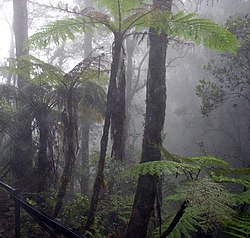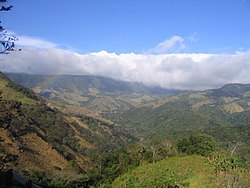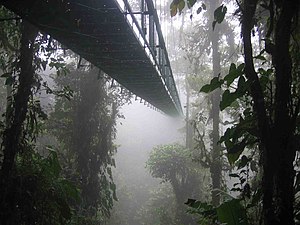Cloud forest







A cloud forest, also called a fog forest, is a generally tropical or subtropical evergreen montane moist forest characterized by a persistent, frequent or seasonal low-level cloud cover, usually at the canopy level. Cloud forests often exhibit an abundance of mosses covering the ground and vegetation, in which case they are also referred to as mossy forests. Mossy forests usually develop on the saddles of mountains, where moisture introduced by settling clouds is more effectively retained.[1]
Distribution and climate
Dependent on local climate, which is affected by the distance to the sea, the exposition and the latidude, the altidude varies from 500 m to 4000 m above sea level. Typically, there is a relatively small band of altitude in which the atmospheric environment is suitable for cloud forest development. This is characterized by persistent mist or clouds at the vegetation level, resulting in the reduction of direct sunlight and thus of evapotranspiration. Within cloud forests, much of the precipitation is in the form of fog drip, where fog condenses on tree leaves and then drips onto the ground below. Tropical cloud forests extend from 23°N to 25°S latitudes and occur to a relatively narrow altitudinal zone with a special atmospheric environment which is characterized by at the vegetation level. [2] Annual rainfall can range from 500 to 10000 mm/year and mean temperature between 8 to 20°C. [3] While cloud forest today is the most widely used term, in some regions these ecosystems or special types of cloud forests are called mossy forest, elfin forest, montane thicket, dwarf cloud forest, nuboselva, bosque montano nebuloso, selva de neblina, bosque nuboso, bosque de ceja, selva sublada, nebelwald, wolkenwald, forêt néphéliphile, forêt de nuage, unmu-rin, bosque anao, foresta nebular, mata nebular, matinha nebular, floresta fe neblina, floresta nuvigena, mata de neblina, matinha de altitude, floresta nublada, and floresta pluvial montana e/ou alto montana. [4] The definition of cloud forest can be ambiguous, with many countries not using the term (preferring such terms as Afromontane forest and upper montane rain forest, or more localised terms such as the Bolivian yungas, and the laurisilva of the Atlantic Islands), and occasionally subtropical and even temperate forests in which similar meteorological conditions occur are considered to be cloud forests. Only 1% of the global woodland is covered by cloud forests. [5] Important areas of cloud forest are in Central- and South America, East- and Central Africa, Indonesia, Malaysia, at the Philippines, Papua-New Guinea and in the Caribbean. (see following list and [1])
Tropical and subtropical cloud forests exist in the following countries:
- Angola
- Argentina
- Australia
- Bangladesh
- Bolivia
- Brazil
- Brunei
- Burundi
- Cambodia
- Cameroon
- China
- Colombia
- Costa Rica
- Democratic Republic of Congo
- Dominica
- Ecuador
- El Salvador
- Fiji
- Gabon
- Guatemala
- Guyana (Pakaraima Mountains)
- Honduras
- India
- Indonesia
- Jamaica (Blue and John Crow Mountains National Park)[6]
- Kenya
- La Réunion (France)
- Madagascar
- Malaysia
- Mexico
- Federated States of Micronesia
- Mozambique
- Myanmar
- Nicaragua
- Oman
- Pakistan
- Panama
- Papua New Guinea
- Peru
- Philippines
- Rwanda
- Samoa
- Spain (Canary Islands)
- Sri Lanka
- Tanzania
- Trinidad and Tobago
- United States (Hawaiʻi, Puerto Rico)
- Venezuela
- Vietnam
Temperate cloud forests
Although far from being universally accepted as true cloud forests, several forests in temperate regions have strong similarities with tropical cloud forests. The term is further confused by occasional reference to cloud forests in tropical countries as "temperate" due to the cooler climate associated with these misty forests.
Distribution of temperate cloud forests
- Argentina - Catamarca and Tucumán
- Australia - Lamington National Park (Queensland)
- People's Republic of China - Yunnan Plateau, mountains of southern and eastern China
- Japan - parts of Yakushima Island
- New Zealand - parts of Fiordland, Mount Taranaki and Mount Cargill, near Dunedin.
- Portugal - Azores and Madeira
- South Africa
- Spain - Canary Islands (laurisilva)
- Taiwan
Characteristics
In comparison with lower tropical moist forests, cloud forests show a reduced tree stature combined with increased stem density and generally the lower diversity of woody plants. [7] Trees in these regions are generally shorter and more heavily stemmed than in lower altitude forests in the same regions, often with gnarled trunks and branches, froming dense, compact crownes. Their leaves become smaller, thicker and harder with increasing altitude. [8] The high moisture promotes the development of a high biomass and biodiversity of epiphyte, particularly bryophytes, lichens,ferns including filmy ferns, bromeliads and orchids. [9] The number of endemic plants can be very high. [10] An important feature of cloud forests is that the tree crowns can intercept the wind-driven cloud moisture, part of which drips to the ground. This water stripped from the coulds is termed horizontal or occult (because it is not recorded with normal rainfall measurement) precipitation, and can be an important contribution to the hydrologic cycle. [11] Due to the frequently high water content of soils, the reduced solar radiation and the low rates of decompositon and mineralistion the soil acidity is very high [12], with mor humus and peat often forming the upper soil layer. [13] Stadtmüller (1987) distinguishes two general types of tropical montane cloud forests: • areas with a high annual precipitation due to a frequent cloud cover in combination with heavy and sometimes persistent orographic rainfall; such forests have a perceptible canopy strata, a high number of epiphytes and a thick peat layer which has a high storage capacity for water and control the runoff; • in drier areas with mainly seasonal rainfall cloud stripping can amount to a large proportion of the annual precipitation.
Importance of cloud forests
- Watershed function. Because of the cloud stripping strategy the effective rainfall can be doubled in dry seasons and increase the wet season rainfall by about 10 percent.[14] [15] Experiments of Costin and Wimbush (1961) showed that the tree canopies of non-cloud forests intercept and evaporate 20 percent more of the precipitation than cloud forests, which means a loss to the land component of the hydrological cycle.
- Vegetation. Tropical montane cloud forests are not as species-rich as tropical lowland forests but they provide the habitats for many species that are found nowhere else. [16] [17] For example, the Cerro de la Neblina, a cloud covered mountain in the south of Venezuela accommodates many shrubs, orchids and insectivorous plants which are restricted to this mountain only.[18]
- Fauna. The endemism in animals is also very high. In Peru, more than one third of the 270 endemic birds, mammals and frogs are found in cloud forests. [19] One of the best known cloud forest mammal is the Mountain Gorilla (Gorilla g. beringei). Many of those endemic animals have important functions such as seed dispersal and forest dynamics in this ecosystems. [20]
Current situation
1970 the original extend of cloud forests was around 50 million hectares. Population growth, poverty and uncontrolled land use all contribute to the loss of cloud forests. The 1990 Global Forest Survey found that 1.1% of tropical mountain and highland forests were lost each year, which was higher than in any other tropical forests. [21] For example, in Colombia, one of the countries with the largest area of cloud forests, only 10-20% of the initial cloud forest cover remains. [22] Significant areas have been converted to plantations, agriculture and pasture. Important crops in montane forest zones are tea and coffee, but also logging special species such as Podocarpus causes changes to forest structure. [23] Currently, a third of all cloud forests are protected. [24]
Impact of climate change on cloud fortests
Because of their delicate dependency on local climate, cloud forests will strongly be affected by the global climate change. A number of climate models suggest that the low-altitude cloudiness will be reduced, which means that the optimum climate for many cloud forest habitats will increase in altitude. [25] Linked to the reduction of cloud moisture immersion and increasing temperature, the hydrological cycle will change with the consequence that the system will dry out. [26] This can result in the wilting and the death of epiphytes, which rely on high humidity. [27] Also frogs and lizards are expected to suffer from increased drought. [28] In addition, climate changes can result in a higher amount of hurricans, which may increase damage to tropical montane cloud forests. All in all the results of the climate change will be a loss in biodiversity, altidue shifts in species ranges and community reshuffling and in some areas complete loss of cloud forests. [29]
References
- ^ Clarke, C.M. 1997. Nepenthes of Borneo. Natural History Publications (Borneo), Kota Kinabalu, p. 29.
- ^ (Häger, 2006; Hamilton et al., 1995)
- ^ (Häger 2006; Hamilton et al., 1995)
- ^ (Hamilton et al., 1995)
- ^ (Häger, 2006)
- ^ Blue and John Crow Mountains National Park - UNESCO World Heritage Centre Retrieved 2008/03/26
- ^ (Hamilton et al., 1995; Häger, 2006)
- ^ (Bruijnzeel and Proctor quote from Hamilton et al., 1995)
- ^ (Hamilton et al., 1995; Häger 2006)
- ^ (Häger, 2006)
- ^ (Hamilton et al., 1995)
- ^ (Hamilton et al., 1995; Van Steenis, 1972 and Grubb and Tanner, 1976)
- ^ (Hamilton et al., 1995)
- ^ (Vogelmann, 1973 and Bruijnzeel, 1990 quote by Hamilton et al., 1995)
- ^ (Garcia-Santos, 2007)
- ^ (Bruijnzeel and Hamilton, 2000)
- ^ (Garcia-Sntos, 2007)
- ^ (Bruijnzeel and Hamilton, 2000)
- ^ (Bruijnzeel and Hamilton, 2000)
- ^ (Hamilton et al., 1995)
- ^ (Bruijnzeel and Hamilton, 2000)
- ^ (Häger, 2006)
- ^ (Hamilton et al., 1995)
- ^ (Kapelle, 2004 quote by Häger, 2006)
- ^ (Foster, 2001, Bubb et al. 2004)
- ^ (Bubb et al., 2004)
- ^ (Foster, 2001)
- ^ (Bubb et al., 2004)
- ^ (Foster, 2001)
- Bruijnzeel, L.A., Hamilton, L.S., 2000, Decision Time For Cloud Forests, Water-Related Issues And Problems Of The Humid Tropics And Other Warm Humid Regions- IHP Humid Tropics Programme Series No.13
- Foster, P., 2001, The potential negative impacts of global climate change on tropical montane cloud forests, Elsevier Science/ Earth-Science Review* Bubb, P., May, I., Miles, L., Sayer, J., 2004, Cloud Forest Agenda, UNEP-WCMC, Cambridge, UK, http://www.unep.wcmc.org/resouces/publicashions/UNEP_WCMC_bio_series/20.htm
- García-Santos, G., Marzol, M. V., and Aschan, G. (2004) Water dynamics in a laurel montane cloud forest in the Garajonay National Park (Canary Islands, Spain), Hydrol. Earth Syst. Sci., 8, 1065-1075. http://www.hydrol-earth-syst-sci.net/8/1065/2004/hess-8-1065-2004.html
- Häger, A., 2006, Einfluss von Klima und Topographie auf Struktur, Zusammensetzung und Dynamik eines tropischen Wolkenwaldes in Monteverde, Costa Rica, Göttingen: Disssertation Georg August Universität Göttingen
- García-Santos, G. (2007). An eco-hydrological and soils study in a montane cloud forest in the National Park of Garajonay, La Gomera (Canary Islands, Spain). PhD Dissertation, Amsterdam: VU University. http://dare.ubvu.vu.nl/handle/1871/12697
- García-Santos, G., Bruijnzeel, L.A. and Dolman, A.J. (2009). Modelling canopy conductance under wet and dry conditions in a subtropical cloud forest. Journal Agricultural and Forest Meteorology, 149 (10), 1565-1572 doi:10.1016/j.agrformet.2009.03.008
External links
- Laurisilva Montane Cloud Forest in the National Park of Garajonay, Canary Islands
- Monteverde Costa Rica Cloud Forest
- Tropical Montane Cloud Forest Initiative
- National Geographic (2001), "Cloud Forests Fading in the Mist, Their Treasures Little Known"
- An Ecological Reserve in the Cloud Forest of Mindo Ecuador
- St. Elena and Rara Avis, Costa Rica - Video
- Tropical hydrology and cloud forests project
- Hydrology of tropical cloud forests project
- Cloud Forest Video - Rara Avis CR
